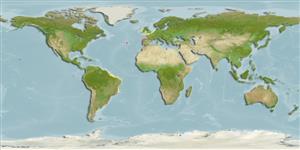>
Blenniiformes (Blennies) >
Blenniidae (Combtooth blennies) > Salariinae
Etymology: Hypleurochilus: Greek, hypo = under + Greek, pleura = in the side of + Greek, cheilos = lip.
More on authors: Quoy & Gaimard.
Environment: milieu / climate zone / depth range / distribution range
Ökologie
seewasser demersal. Tropical
Southwest Atlantic: Paraíba, Brazil (Ref. 57756) to Uruguay (Ref. 35204) and Argentina (Ref. 86332). Northeast Atlantic: Azores (Ref. 35204).
Size / Gewicht / Alter
Maturity: Lm ? range ? - ? cm
Max length : 8.9 cm TL Männchen/unbestimmt; (Ref. 116953)
Adults feed primarily on amphipods and isopods (Ref. 9062). Oviparous. Eggs are demersal and adhesive (Ref. 205), and are attached to the substrate via a filamentous, adhesive pad or pedestal (Ref. 94114). Larvae are planktonic, often found in shallow, coastal waters (Ref. 94114).
Life cycle and mating behavior
Geschlechtsreife | Fortpflanzung | Ablaichen | Eier | Fecundity | Larven
Oviparous, distinct pairing (Ref. 205).
Menezes, N.A. and J.L. Figueiredo, 1985. Manual de peixes marinhos do sudeste do Brasil. V.Teleostei (4). Museu de Zoologia, Universidade de São Paulo, Brazil. 105 p. (Ref. 9062)
IUCN Rote Liste Status (Ref. 130435: Version 2024-2)
Bedrohung für Menschen
Harmless
Nutzung durch Menschen
Tools
Zusatzinformationen
Download XML
Internet Quellen
Estimates based on models
Preferred temperature (Ref.
123201): 14.9 - 27.7, mean 23.6 °C (based on 330 cells).
Phylogenetic diversity index (Ref.
82804): PD
50 = 0.5005 [Uniqueness, from 0.5 = low to 2.0 = high].
Bayesian length-weight: a=0.00832 (0.00448 - 0.01544), b=2.99 (2.82 - 3.16), in cm total length, based on LWR estimates for this species & (Sub)family-body (Ref.
93245).
Trophic level (Ref.
69278): 3.3 ±0.53 se; based on food items.
Widerstandsfähigkeit (Ref.
120179): hoch, Verdopplung der Population dauert weniger als 15 Monate. (Preliminary K or Fecundity.).
Fishing Vulnerability (Ref.
59153): Low vulnerability (10 of 100).
